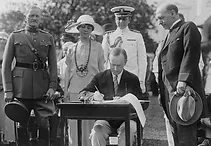Activity 3.2: How did U.S. Immigration Laws shape Sammy Lee’s Life?

Students learn key laws in the early 20th century that limited the rights of Asian immigrants in the United States, situate these laws in the context of Sammy Lee’s life, and consider how these laws impacted Sammy Lee, his family, and other Korean Americans. Finally, they consider how to advocate for Korean American immigrants.
U.S. President Calvin Coolidge signs the Immigration Act on the White House South Lawn along with appropriation bills for the Veterans Bureau. John J. Pershing is on the left. Source: Wikipedia
Activity Questions
- How did U.S. Immigration Laws impact Sammy Lee and his family?
- How did immigration laws in the United States evolve during the 20th century?
- How do these laws impact Korean-Americans today?
- What remains to be done to improve U.S. immigration laws?
- How can we advocate for immigrant community like Korean American community?
Instructional Strategies
- To support these activities, use the Lesson 3 Presentation.
Think/Pair/Share
- Begin this lesson by having students pair up and brainstorm the definitions of the following key concepts: white supremacy, race-based segregation, aliens ineligible for citizenship, and Dixiecrats. Call on pairs to share their definitions.
Learning More About Sammy Lee
- Introduce the Lesson question: How Did U.S. Immigration Laws impact Sammy Lee and his family?
- Have students read the next two sections of A Biographical Overview of Sammy Lee and annotate the text to highlight these terms and references to immigration laws, policies, and court cases.
Overview of Immigrant Law
- Review the first two slides on immigration law (What is Immigration Law? and Immigration Laws, 1870-1927) and have students identify where Sammy Lee encountered these laws.
- Review the third slide (Immigration Laws, 1950-present) and have students share how these laws might impact Korean American immigrants today.
Double-Sided Timelining
- Individually, with a partner, or in small groups, have students create a double-sided timeline. Distribute and review the Double-Sided Timeline Directions.
- One side should identify critical immigration laws and cases, and the other side should identify important events in Sammy Lee’s life (alternatively, they could interview a family member who was an immigrant). The timeline can be created on paper or digitally.
- Allow students time to complete their timelines.
Closing the Activity
- Review the final two slides (What ideals now govern United States immigration law? and Advocates for Korean American Immigrants). Ask students to share their ideas on what remains to be done to improve U.S. immigration laws and how we can advocate for Korean American immigrants.
Resources
- Lesson 3 Teacher’s Guide and Lesson 3 Presentation are found under Lesson 3 Overview.
- Handout: Sammy Lee Timeline
- Handout: Double-Sided Timeline Directions

